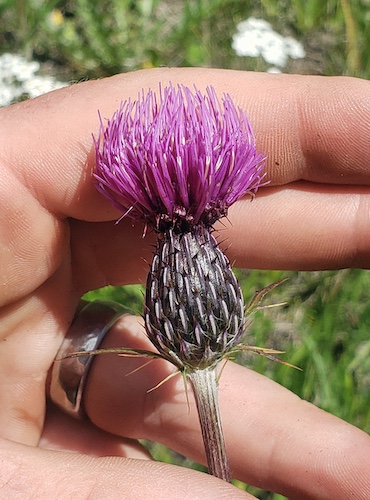 Photo of the flower of a Graham’s Thistle – photo credit John Gorey“A New Thistle Species in the High Mogollon Mountains?” – Presentation by biologist John Gorey, sponsored by the Gila Native Plant Society
Photo of the flower of a Graham’s Thistle – photo credit John Gorey“A New Thistle Species in the High Mogollon Mountains?” – Presentation by biologist John Gorey, sponsored by the Gila Native Plant Society
On Friday, November 17, 2023, at 7:00 pm, the Gila Native Plant Society will feature a presentation by John Gorey, wildlife biologist, entitled ““Graham's Thistle Update 2023 and New Thistle Species of the High Mogollon Mountains?” The program will be presented live at Harlan Hall on the WNMU Campus in Room 111, as well as via Zoom for those who prefer to attend online. As always, the public is welcome. Anyone interested in joining in the Zoom presentation may request a link from gilanative@gmail.com .
While researching the rare Graham’s Thistle (Cirsium grahamii) in the mountains in 2022, John Gorey came across another thistle that he could not immediately identify. Experts on New Mexico flora whom he consulted speculate that it may be a species new to science, endemic to the high Mogollons. Funded by grants from the Native Plant Society of New Mexico and the Gila Chapter, this past year he not only followed up his previous sightings of Graham's Thistle with surveys for the plant in new areas, but also launched a new, exciting rare plant expedition in the high elevations of the Mogollon Mountains. He will present his findings (on both the plants and the pollinators) from 2022 and 2023.
John Gorey received his bachelor degree in wildlife biology from Murray State University in 2008. Since graduating he has spent the last 14 years as a wildlife biologist studying birds, insects, plants, and habitats across the US from Alaska to Maine and many places between. Since moving to New Mexico in 2017 he has focused his research efforts on southwestern New Mexico.
The Gila Native Plant Society is committed to promoting education, research and appreciation of the native flora of the Southwest; encouraging the preservation of rare and endangered plant species; and supporting the use of suitable native plants in landscaping. For information on programs, publications and membership, please visit www.gilanps.org .